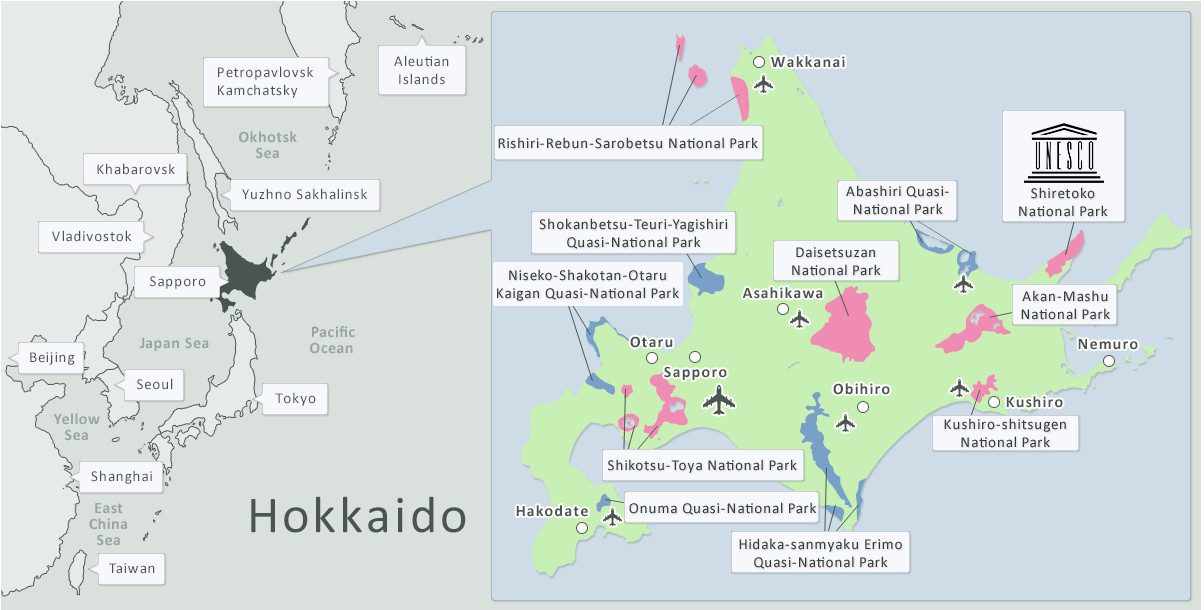
Hokkaido is Japan’s northernmost Island with an area of 77,984km² and a 2,676km long coastline (excluding off shore islands). This is 630km 8hours driving from the north (Wakkanai) to the south (Hakodate), and 430km 6hours driving from the west (Sapporo) to the east (Nemuro) across the island. Hokkaido is not enormously large as you can drive across the island within a day. Although it is not a big island, it is large enough to hold many distinctive environments, such as wetlands and rivers, forests and lakes, mountains, coasts and off shore islands.
Wetlands and Rivers
Hokkaido has many distinct wetlands along the coast as well as in land or even in the mountains. Rivers run across the land like veins providing water and nutrients to the flora and fauna. This environment nurtures complex ecosystems with high biodiversity. Wetland is called “the cradle of life”. Roughly speaking there are 2 types of wetland, one is marsh with alkaline rich nutrients, thus high biodiversity, like the Kushiro Wetland or the Sarobetsu Wetland. Expansive flat land gives you wide view to observe its wild life. Another type is bog with low nutrients thus low biodiversity in mountain environment, like Uryunuma or Daisetsuzan area. It is surprising when you bump into an vast, open space while walking in a deep forest. The most wetlands have boardwalks to where its uniqueness is seen.
Forests and Lakes
Hokkaido’s forests are in the temperate zone and the subarctic zone. A variety of forests exist in Hokkaido, like beech forests in the southern part, mixed needleleaf-broadleaf forests in central Hokkaido and conifer forests in the east and north. From April to June, the flowers on the forest floor expandingly bloom after the snow melts, and insects and other animals come into action. You will feel the active energy of the forest. September and October is the season of autumn coloring with a palette of yellow, red and orange and all colors in between. These warm colors match well with the green of the pine trees and the blue of the lakes. This is even better when you see snowcapped peaks in the background. Many lakes are formed by volcanic activities. They are deep and contain less organic substance, so the water is clear. They give you a wonderful refreshment during walking.
Mountains
Mountains in Hokkaido are relatively low compared to other areas of Japan. The highest peak is Mt. Asahidake with 2291m, however the attraction of Hokkaido mountains is not only the height, but more the expansive scale of the mountain range such as the Daisetsuzan Mountain Range which is formed by volcanic activities, or the sharp and precipitous peaks of the Hidaka mountain ranges which is formed by folding activities. Because of Hokkaido’s harsh climate conditions, the forest line is about 1,000m in Shiretoko or 1500m in Daisetsuzan. Panoramic views, which stretch for tens of kilometers across this beautiful land, are a reward when reaching the high areas. You will see alpine flowers specific to Hokkaido or some may even be specific to the mountain.
Coasts and Off Shore Islands
Hokkaido is surrounded by three oceans, the Sea of Japan, the Pacific Ocean and the Sea of Okhotsk. Giant konbu (seaweed) are the evidence of a rich sea and provide shelter for seals. Sea otters, sea lions or killer whales can be seen frequently. Salmon come back to the river they were born to lay their roe in autumn. There is always something happening in the sea and so walking along the coast is always interesting although you must keep an eye on the ocean side. The courses are not so long but just right for stretching your legs during a long drive. Off shore islands, such as the flower island Rebun, Mt. Fuji shaped 360deg panoramic view island Rishiri, or the sea bird paradise Teuri, are unique in terms of its ecosystem and extreme in the amount of wildlife they support. Encounters with locals can be memorable experiences to know about the island more.